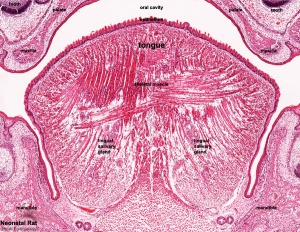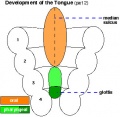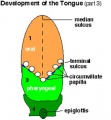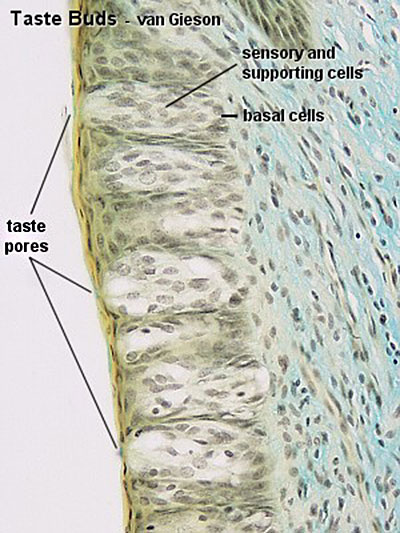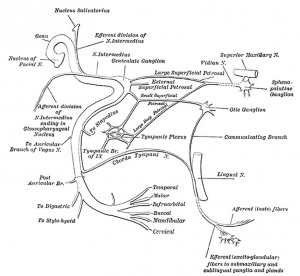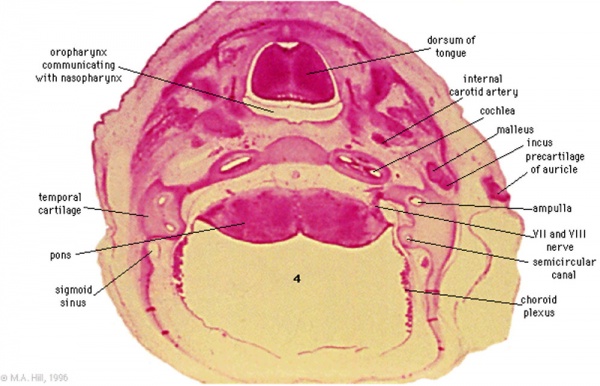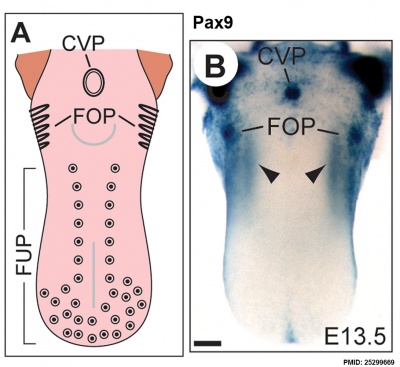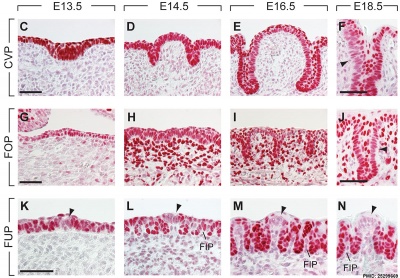Sensory - Taste Development
| Embryology - 27 Apr 2024 |
|---|
| Google Translate - select your language from the list shown below (this will open a new external page) |
|
العربية | català | 中文 | 中國傳統的 | français | Deutsche | עִברִית | हिंदी | bahasa Indonesia | italiano | 日本語 | 한국어 | မြန်မာ | Pilipino | Polskie | português | ਪੰਜਾਬੀ ਦੇ | Română | русский | Español | Swahili | Svensk | ไทย | Türkçe | اردو | ייִדיש | Tiếng Việt These external translations are automated and may not be accurate. (More? About Translations) |
Introduction
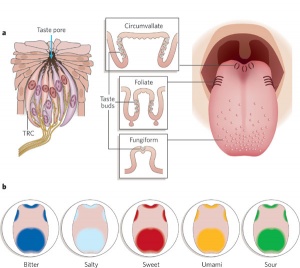
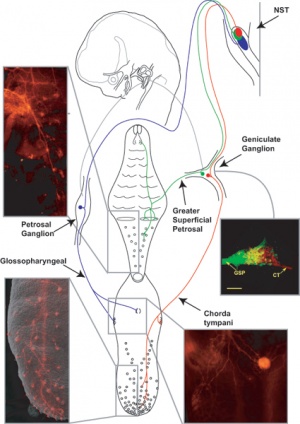
These notes introduce the development of the sense of taste which can divided into five basic tastes: bitter, salty, sweet, umami (savoury) and sour. Current research appears to have displaced the historic concept of a tongue "map".
A study in rat suggests that neonatal changes in circumvallate papillae may result in postnatal changes in "taste".[3]
In frogs, a large taste disc (TD) is the largest vertebrate gustatory organ. Postnatally, the sense of taste is also closely related to the sense of smell.
| Taste Links: Introduction | Student project | Tongue Development | Category:Taste | ||
|
| Senses Links: Introduction | placode | Hearing and Balance hearing | balance | vision | smell | taste | touch | Stage 22 | Category:Sensory |
Some Recent Findings
|
| More recent papers |
|---|
|
This table allows an automated computer search of the external PubMed database using the listed "Search term" text link.
More? References | Discussion Page | Journal Searches | 2019 References | 2020 References Search term: Taste Development | Taste Embryology |
| Older papers |
|---|
|
Development Timing
These are human embryonic timings[12], not clinical which is based on last menstral period +2 weeks GA.
Week 6 - gustatory papilla, caudal midline near the foramen caecum
Week 6-7 - nerve fibers approach the lingual epithelium
Week 8 - nerves penetrate epitheilai basal lamina and synapse with undifferentiated, elongated, epithelial cells (taste bud progenitor cell)
Week 10 - shallow grooves above the taste bud primordium
Week 12 - first differentiated epithelial cells (Type II and III)
Week 12 -13 - maximum synapses between cells and afferent nerve fibers
Week 14 - 15 - taste pores develop, mucous
Week 18 - substance P detected in dermal papillae, not in taste bud primordia
3rd Trimester -
- Links: Timeline human development
Tongue Development
Tongue Development Parts
Tongue Week 8, (GA week 10)
Taste Buds
Circumvallate papilla are tongue surface specialisation of large size, varying in number (8-12) forming an inverted letter V shape on the dorsum of the tongue immediately in front of the foramen cecum and sulcus terminals. Numerous "taste buds" are located on the sides of these circumvallate papilla (vallate papilla)as well as with fungiform papilla. The three types of tongue papillae from numerous to few are: filiform, fungiform and circumvallate.
Other adult locations include the fimbriæ linguæ, under surface of the soft palate, and on the posterior surface of the epiglottis.
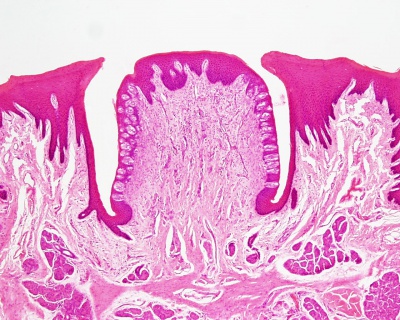
|
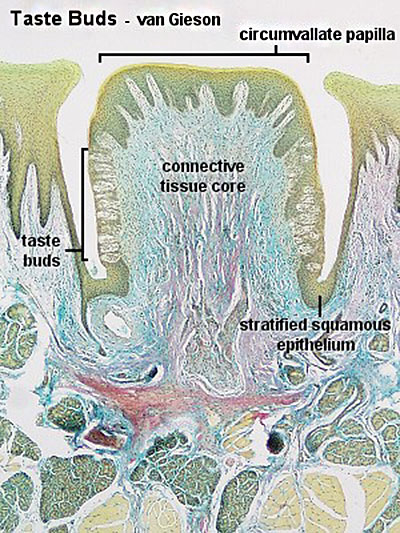
|
Gustatory Cranial Sensory Neurons
Cranial nerves VII, IX and X have dual embryonic origins and provide both gustatory (taste) and non-gustatory (touch, pain, temperature) sensory innervation to the oral cavity of vertebrates.
Gustatory Neurons
- originate from epibranchial placodes
- innervate taste buds
- project centrally to the rostral nucleus of the solitary tract (NTS)
General Epithelial Innervation of the oral cavity
- originate from cranial neural crest
- innervation to the oropharynx
- project to non-gustatory hindbrain regions (spinal trigeminal nucleus)
(text based on: Embryonic origin of gustatory cranial sensory neurons.[13])
Stage 22
Section (B4) through head showing tongue and head structures.
Mouse
Images and data.[14]
Abnormalities
References
- ↑ Chandrashekar J, Hoon MA, Ryba NJ & Zuker CS. (2006). The receptors and cells for mammalian taste. Nature , 444, 288-94. PMID: 17108952 DOI.
- ↑ Krimm RF. (2007). Factors that regulate embryonic gustatory development. BMC Neurosci , 8 Suppl 3, S4. PMID: 17903280 DOI.
- ↑ Sbarbati A, Crescimanno C, Merigo F, Benati D, Bernardi P, Bertini M & Osculati F. (2001). A brief survey of the modifications in sensory-secretory organs of the neonatal rat tongue. Biol. Neonate , 80, 1-6. PMID: 11474141 DOI.
- ↑ Qin Y, Sukumaran SK & Margolskee RF. (2021). Nkx2-2 expressing taste cells in endoderm-derived taste papillae are committed to the type III lineage. Dev Biol , 477, 232-240. PMID: 34097879 DOI.
- ↑ Yu W, Wang Z, Marshall B, Yoshida Y, Patel R, Cui X, Ball R, Yin L, Kawabata F, Tabata S, Chen W, Kelsh RN, Lauderdale JD & Liu HX. (2021). Taste buds are not derived from neural crest in mouse, chicken, and zebrafish. Dev Biol , 471, 76-88. PMID: 33326797 DOI.
- ↑ Barlow LA & Klein OD. (2015). Developing and regenerating a sense of taste. Curr. Top. Dev. Biol. , 111, 401-19. PMID: 25662267 DOI.
- ↑ Castillo D, Seidel K, Salcedo E, Ahn C, de Sauvage FJ, Klein OD & Barlow LA. (2014). Induction of ectopic taste buds by SHH reveals the competency and plasticity of adult lingual epithelium. Development , 141, 2993-3002. PMID: 24993944 DOI.
- ↑ Kapsimali M & Barlow LA. (2013). Developing a sense of taste. Semin. Cell Dev. Biol. , 24, 200-9. PMID: 23182899 DOI.
- ↑ Taruno A, Vingtdeux V, Ohmoto M, Ma Z, Dvoryanchikov G, Li A, Adrien L, Zhao H, Leung S, Abernethy M, Koppel J, Davies P, Civan MM, Chaudhari N, Matsumoto I, Hellekant G, Tordoff MG, Marambaud P & Foskett JK. (2013). CALHM1 ion channel mediates purinergic neurotransmission of sweet, bitter and umami tastes. Nature , 495, 223-6. PMID: 23467090 DOI.
- ↑ Petersen CI, Jheon AH, Mostowfi P, Charles C, Ching S, Thirumangalathu S, Barlow LA & Klein OD. (2011). FGF signaling regulates the number of posterior taste papillae by controlling progenitor field size. PLoS Genet. , 7, e1002098. PMID: 21655085 DOI.
- ↑ Thirumangalathu S, Harlow DE, Driskell AL, Krimm RF & Barlow LA. (2009). Fate mapping of mammalian embryonic taste bud progenitors. Development , 136, 1519-28. PMID: 19363153 DOI.
- ↑ Witt M & Reutter K. (1996). Embryonic and early fetal development of human taste buds: a transmission electron microscopical study. Anat. Rec. , 246, 507-23. PMID: 8955790 <507::AID-AR10>3.0.CO;2-S DOI.
- ↑ Harlow DE & Barlow LA. (2007). Embryonic origin of gustatory cranial sensory neurons. Dev. Biol. , 310, 317-28. PMID: 17826760 DOI.
- ↑ Kist R, Watson M, Crosier M, Robinson M, Fuchs J, Reichelt J & Peters H. (2014). The formation of endoderm-derived taste sensory organs requires a Pax9-dependent expansion of embryonic taste bud progenitor cells. PLoS Genet. , 10, e1004709. PMID: 25299669 DOI.
Reviews
Nehring I, Kostka T, von Kries R & Rehfuess EA. (2015). Impacts of in utero and early infant taste experiences on later taste acceptance: a systematic review. J. Nutr. , 145, 1271-9. PMID: 25878207 DOI.
Domínguez PR. (2011). The study of postnatal and later development of the taste and olfactory systems using the human brain mapping approach: an update. Brain Res. Bull. , 84, 118-24. PMID: 21184814 DOI.
Niki M, Yoshida R, Takai S & Ninomiya Y. (2010). Gustatory signaling in the periphery: detection, transmission, and modulation of taste information. Biol. Pharm. Bull. , 33, 1772-7. PMID: 21048297
Chaudhari N & Roper SD. (2010). The cell biology of taste. J. Cell Biol. , 190, 285-96. PMID: 20696704 DOI.
Beauchamp GK & Cowart BJ. (1985). Congenital and experiential factors in the development of human flavor preferences. Appetite , 6, 357-72. PMID: 3911888
Articles
Schwartz C, Issanchou S & Nicklaus S. (2009). Developmental changes in the acceptance of the five basic tastes in the first year of life. Br. J. Nutr. , 102, 1375-85. PMID: 19505346 DOI.
Search PubMed
Search May 2010
- Taste System Development - All (320) Review (64) Free Full Text (78)
- Tongue Development - All (2804) Review (258) Free Full Text (519)
Search Pubmed: Taste System Development | Tongue Development
Historic
Torrey TW. The influence of nerve fibers upon taste buds during embryonic development. (1940) Proc Natl Acad Sci U S A. 26(11):627-34. PMID 16577985
Additional Images
- Tongue Images: Tongue Sk Muscle | Salivary gland sk muscle HE | Unlabeled Salivary gland sk muscle HE | Filiform papillae HE | circumvallate papilla VG | circumvallate papilla HE | Taste buds VG
Glossary Links
- Glossary: A | B | C | D | E | F | G | H | I | J | K | L | M | N | O | P | Q | R | S | T | U | V | W | X | Y | Z | Numbers | Symbols | Term Link
Cite this page: Hill, M.A. (2024, April 27) Embryology Sensory - Taste Development. Retrieved from https://embryology.med.unsw.edu.au/embryology/index.php/Sensory_-_Taste_Development
- © Dr Mark Hill 2024, UNSW Embryology ISBN: 978 0 7334 2609 4 - UNSW CRICOS Provider Code No. 00098G

